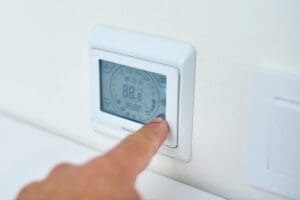For maximum energy efficiency, you should set your thermostat temperature setting to 68 degrees in the winter and 78 degrees in the summer. But when people ask us what the ideal temperature is to set their thermostat, our answer is always – it depends. And it depends on a whole lot of factors.
You can save up to 10% each year on utility bills by setting your thermostat 7 to 10 degrees higher in summer. You can also set it lower in winter for at least eight hours per day. Let’s learn more about how you can maximize cost and comfort by knowing what temperature you should set your thermostat to.

Best Thermostat Temperature Setting for the Winter
With winter temperatures in the west and southwest regions of the U.S. hovering in the 30s and 40s, comfortable indoor temperatures generally need to be a bit higher. Wondering what temperature you should set your thermostat to in the winter? Look no further!
Most experts recommend an indoor temperature of 68 degrees in the winter, turning the thermostat down a few degrees for comfortable sleeping. However, this, of course, depends on the weather outdoors and the preferences of the residents indoors.
Saving Energy in Winter
If your goal is to save money by saving energy in the winter, there are other ways to stay warm instead of cranking the heat.
- Adding layers of sweater, socks, and blankets
- Drink warm beverages and eat soup to warm yourself from the inside
- Keep your oven door open after cooking to allow the escaping air to heat the surrounding area of your home
- Keep your vents clear of any furniture, boxes, curtains, or obstacles in order to maximize the flow of warm air throughout your home
- Get moving – movement and exercise keep your body warm
Where to Keep Your Thermostat During Summer Temperatures
The scorching summer months in Arizona and Nevada are peak times for AC and central air conditioning use. If you’re wondering what temperature you should set your thermostat to in the summer, we’ve got you covered!
Energy efficiency experts say that 72 to 78 degrees is the ideal thermostat temperature setting range in summer. Using the thermostat in the summer might seem counterintuitive, but it makes sense when you consider that it takes less energy to cool your home when your indoor temperature is closer to the outdoor temperature.
How to Conserve Energy in the Summer
While it’s tempting to keep turning up the AC, you can stay cool while saving energy (and money) in summer:
- Close doors and windows during the day, but open them in the evening to help let cooler air circulate
- Turn off the lights, and don’t use the oven or clothes dryer during the day
- Keep window coverings or blinds closed against the heat of the sun
- Don’t use your dishwasher during the day and use only the air-dry feature after it runs at night
- Stay cool by drinking lots of chilled beverages
- Grill outdoors as much as possible
- Use fans cleverly to maximize the flow of cold air through your home
Setting Your Thermostat Temperature When You’re Away
If you’re going on a summer vacation, consider turning your air conditioning off. Turning the thermostat up a few degrees while you’re gone for shorter periods can also cut cooling costs when you return. This is an effective method because the higher indoor temperature slows down the flow of outdoor heat into your home.
For winter, leave your home heated to at least 55 degrees to help keep your pipes from freezing. While you may feel it’s silly to heat your home when you’re not in it, returning home to burst pipes and water damage is a messy, expensive disaster.
The Benefits of a Programmable Thermostat
There are many reasons to switch to a programmable thermostat. Having one installed is an easy, proven way to save a significant amount of money. A programmable thermostat can pay for itself in energy saved within four years or fewer. Once you know what temperature to set your thermostat, you can program it and never touch it again!
It’s critical to ensure that your programmable thermostat is as accurate as possible. If you’re getting inaccurate readings, simply resetting your thermostat can avoid an expensive fix or replacement.
Convenience
When you can set your home’s temperature to change at various times during the day, you can literally set it and forget it. No more worrying about turning down the thermostat before you leave the house or adjusting the temperature at night for comfortable sleeping. It’s taken care of for you.
Energy Efficiency
Some programmable thermostats have energy efficiency programs. But if yours doesn’t, you can save energy by knowing the setting you’re most comfortable at. If you think you’re happiest at 72 degrees, but your thermostat is set to 68 and you’re comfy, you can keep the temperature set there and save energy.
It’s also energy efficient to automatically adjust the temperature when you leave home. That way, you’re not paying to heat or cool an empty house.
App-Controlled
EnergyStar recommends smart thermostats for their ability to be controlled by an app or program even if you’re not home. But did you know that smart thermostats, digital thermostats connected to wifi, have even more advanced capabilities?
If you have an app-controlled thermostat not only are you always in control of the temperature settings and what they hold at, but you can also receive data reports that pinpoint and break down your home’s energy usage
Thermostat Placement Is Important
If your thermostat is placed in an inefficient spot, knowing what temperature you should set it at may have little to no positive effect on your comfort and wallet. Finding the perfect location for your thermostat can save you money and keep you and your family happy.
The best place for a thermostat is on an interior wall in the center of your home. It also helps to place your thermostat in the room you use the most because that’s where you want to be most comfortable.
When installing your thermostat, there are a few places you should avoid putting it. Make sure to avoid placing it in areas that receive direct sunlight and locations above air vents. Placing your thermostat near doors and windows can also decrease its efficiency.
Consider Comfort and Cost When Setting Your Thermostat Temperature
Figuring out which temperature you should set your thermostat to is always a balance between comfort and energy bill savings. When you adjust your setting, it’s important to consider what temperature will provide comfort for you and your family and keep your wallet happy.
If you’re looking to save on your next energy bill, but the thermostat setting is a touchy subject in your house, consider doing a secret experiment. Depending on the season, try setting your thermostat a few degrees up or down to see if anyone notices.
Most people won’t notice a difference of a couple of degrees if they aren’t aware that the thermostat has been changed. If you are comfortable and no one notices the difference, congratulations! You are now able to save a great deal on your energy bill by making a slight adjustment to your thermostat setting.
Schedule Your Home Energy Audit or Programmable Thermostat Installation Today
If you’re looking for ways to save on your stay warm without touching the thermostat, the experts at Ambient Edge have some tips for you! If you visit our page, you’ll be surprised to find out there’s more than a few things you can do to warm up without breaking the bank.
When you schedule a home energy audit with us, we’ll thoroughly assess your home inside and out to let you know how much energy you use and how much energy your home is wasting.


